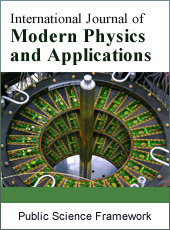International Journal of Modern Physics and Applications
Articles Information
International Journal of Modern Physics and Applications, Vol.1, No.1, Mar. 2015, Pub. Date: Mar. 14, 2015
Quantum Molecular Dynamics Simulation for Multifragmentation Resulting from an Expanding Nuclear Matter
Pages: 6-11 Views: 5806 Downloads: 1135
[01]
A. Abdel-Hafiez, Department of Experimental Nuclear Physics, Nuclear Research Center, Atomic Energy Authority, Cairo, Egypt.
[02]
M. E. Medhat, Department of Experimental Nuclear Physics, Nuclear Research Center, Atomic Energy Authority, Cairo, Egypt.
Quantum molecular dynamics (QMD) is used to investigate multifragmentation resulting from an expanding nuclear matter. Equation of state, the structure of nuclear matter and symmetric nuclear matter is discussed. Also, the dependence of the fragment mass distribution on the initial temperature (Tinit) and the radial flow velocity (h) is studied. When h is large, the distribution shows exponential shape, whereas for small h, it obeys exponentially falling distribution. The fragmentation mechanism in an expanding system is found to be different from the one in a thermally equilibrated system. The used Hamiltonian has a classical kinetic energy term and an effective potential term composed of four parts.
Quantum Molecular Dynamics, Expanding Nuclear Matter, Multifragmentation, Fragment Mass Distribution
[01]
J. Schmelzer, G. Ro¨pke, and F.-P. Ludwig, Phys. Rev. C 55, 1917 [1997]
[02]
A. Strachan and C. O. Dorso, Phys. Rev. C 59, 285 [1999]
[03]
M. L. Gilkes et al., Phys. Rev. Lett. 73, 1590 [1994]
[04]
P. F. Mastinu et al., Phys. Rev. Lett. 76, 2646 [1996]
[05]
M. Petrovici et al., Phys. Rev. Lett. 74, 5001 [1995]
[06]
W. Reisdorf et al., Nucl. Phys. A612, 494 [1997]
[07]
M. E. Fisher, Rep. Prog. Phys. 30, 615 [1967]; in Critical Phenomena, Proceedings of the International School of Physics, Enrico Fermi Course LI, edited by M. S. Green [Academic, New York, 1971]
[08]
I. N. Mishustin, Nucl. Phys. A630, 111c [1998]
[09]
M. Belkacem, V. Latora, and A. Bonasera, Phys. Rev. C 52, 271 [1995]
[10]
M. Colonna and Ph. Chomaz, Phys. Lett. B 436, 1 [1998]
[11]
P. Finocchiaro, M. Belkacem, T. Kubo, V. Latora, and A. Bonasera, Nucl. Phys. A600, 236 [1996]
[12]
A. Ohnishi and J. Randrup, Phys. Lett. B 394, 260 [1997]
[13]
Y. Sugawa and H. Horiuchi, Phys. Rev. C 60, 064613 [1999]
[14]
M. Colonna and Ph. Chomaz, Phys. Rev. C 49, 1908 [1994], and references therein
[15]
V. Baran, M. Colonna, M. Di Toro, and A. B. Larionov, Nucl. Phys. A632, 287 [1998]
[16]
A. Guarnera, M. Colonna, and Ph. Chomaz, Phys. Lett. B 373, 267 [1996]
[17]
S. Ayik, M. Colonna, and Phys. Lett. B 353, 417 [1995]
[18]
C. O. Dorso, S. Duarte, and J. Randrup, Phys. Lett. B 188, 287 [1987]
[19]
T. Maruyama, K. Niita, K. Oyamatsu, T. Maruyama, S. Chiba, and A. Iwamoto, Phys. Rev. C 57, 655 [1998]
[20]
Toshiki Maruyama, Koji Niita, Kazuhiro Oyamatsu, Tomoyuki Maruyama, Satoshi Chiba and Akira Iwamoto, Phys. Rev.C, Vol.57, No.2 [1998]
[21]
S.Das Gupta, A.Z.Mekjian and B.Tsang, Advances in Nuclear Physics, V26, 89, 2001 ( J.Negele and E.Vogt, editors)
[22]
C.B.Das, S.Das Gupta, W.Lynch, A.Z.Mekjian and B.Tsang, Phys. Reports, 406,1 (2005)
[23]
Shinpei Chikazumi, Toshiki Maruyama, Satoshi Chiba, Koji Niita, and Akira Iwamoto, phys. Rev.C 63, 024602[2001]
[24]
B. L. Holian and D. E. Grady, Phys. Rev. Lett. 60, 1355 [1988]
[25]
W. Reisdorf et al., Nucl. Phys. A612, 494 [1997]

ISSN Print: 2381-6945
ISSN Online: 2381-6953
Current Issue:
Vol. 7, Issue 1, March Submit a Manuscript Join Editorial Board Join Reviewer Team
ISSN Online: 2381-6953
Current Issue:
Vol. 7, Issue 1, March Submit a Manuscript Join Editorial Board Join Reviewer Team
| About This Journal |
| All Issues |
| Open Access |
| Indexing |
| Payment Information |
| Author Guidelines |
| Review Process |
| Publication Ethics |
| Editorial Board |
| Peer Reviewers |


